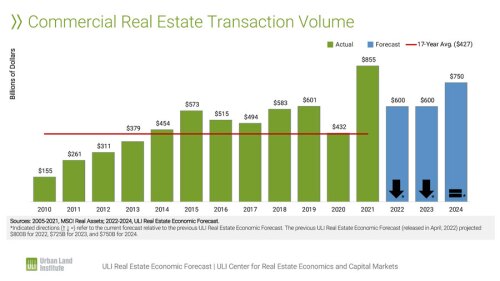ULI and PwC US has released Emerging Trends in Real Estate® 2023, an annual report highlighting the trends shaping the real estate industry. In its 44th edition, the report includes proprietary data and insights from more than 2,000 leading real estate industry experts, exploring shifts in the property sector since the pandemic, changing investor sentiment toward climate risks, the emergence of impact investing, and other real estate issues within the United States and Canada.
Insights from the report reconfirm two bifurcated market trends: aspects of the real estate industry are “normalizing” and reverting to pre-COVID patterns while others have permanently shifted to the “new normal” that was adopted with the pandemic.
“As we enter 2023, the pandemic-driven factors that upended the global economy for more than two years are starting to fade,” said Anita Kramer, senior vice president of ULI’s Center for Real Estate Economics and Capital Markets. “At the same time, structural changes like the widespread adoption of remote work will likely continue to inform investor behavior. A series of long-term factors such as the rising cost of housing, increased climate risk, and declining socioeconomic mobility pose continued uncertainty for the private and public sectors alike. There are also opportunities – the increase in federal infrastructure spending provides the chance to create greener and more equitable communities that can adapt to these challenges.”
The report also highlights the real estate industry’s move to look beyond cyclical headwinds and focus on a long-term approach to real estate assets. In an environment with rising interest rates, declining GDP, and minimized deal activity, the industry is opting to ride out the slump and position itself for sustained growth and strong returns.
“The past few years have been historic territory for the real estate industry, and the pandemic has permanently changed how and where we use different types of properties,” said Byron Carlock, US real estate leader for PwC. “There are several factors at play determining both the near and long-term future of the industry. Although real estate capital markets are constricting, they are still open for business, investors are still buying high-quality properties, lenders will continue to lend, and companies should move forward with cautious optimism through this current cycle and prepare to adapt to quick market changes. The industry should also work closely with stakeholders to help assess they are addressing demands and shifting sentiments while building trust.”
Additional key insights from the report include:
The market is normalizing
Marked by the cooling of the housing market, the industry is continuing to sell, just not at the record pace experienced in 2021 and the first half of 2022. The U.S. commercial property market had an incredible run, with some of the strongest returns, rent growth, and price appreciation rates ever recorded. The industrial sector is seeing similar changes; however, it still has record-low vacancy rates, which can be attributed to the demand for high-quality, well-located logistics facilities that can keep up with the demand of the supply chain. Other markets within real estate are trending back up to their pre-pandemic normal, including the hotel sector and property investments.
But costs remain high
While housing costs began to fall modestly in the summer, housing is still too expensive. The existing U.S. median home price has jumped more than 30% since the pandemic began, putting housing affordability at its lowest level relative to income in more than three decades. Rent prices continue to surpass historic levels, and the demand for rental units is far outstripping supply.
The chronic undersupply of affordable housing is not a new challenge, and many of the factors contributing to this challenge remain the same: restrictive codes and building zones blocking or limiting new supply, increased complexity around affordable housing development deals, homebuilders’ cautious construction pacing, and ongoing sector labor shortages.
Millions of people are taking matters into their own hands and moving to more affordable markets, such as the Sun Belt. However, while that worked as a solution for early movers, prices and rents are now increasing in the very same places people went to seek affordability.
Companies are reassessing office space
As employers and employees settle on their work preferences, many firms are keeping their offices in case of potential future use or due to leasing contracts. While more firms are downsizing, terminating their leases at renewal, or turning to sublets as a temporary solution, a mass departure from office buildings is unlikely.
Unique spaces still attract people, and therefore companies need to reassess their spaces to determine they are relevant to their operational needs and play a role in securing and retaining talent.
Addressing climate change impacts and ESG demands
The intensifying impact of climate change is altering the dynamics of where people want to live. The combination of rising temperatures and drought may soon limit where we can build, and some cities are already pausing new developments for this reason.
Stakeholders are actively seeking greater environmental, social, and governance (ESG) disclosures and given the investors’ market size and current capital demands, the industry cannot ignore ESG protocols. Investors and other stakeholders are calling for voluntary action, and the SEC has proposed regulations that would require greater disclosure, transparency, and enhanced consistency in reporting. The demand from investors is pushing the market toward establishing newer, greener, and more energy-efficient buildings and seeking ways to limit greenhouse gas emissions (GhG). The Inflation Reduction Act of 2022 also includes programs designed to reduce GhG and reverse or slow climate change.
Considering the potential impact of unchecked climate change, the rising demand from stakeholders, and pending regulation, it’s important the industry does not wait to get ahead of the inevitable here. ESG impacts how businesses create value and their ability to attract and retain customers and attract talent and capital.
Shifting investor sentiment and capital
The investor demand for real estate has cooled since last year, with many focusing their attention on other types of assets, such as equities and bonds. Rising interest rates are increasing costs around acquisition and construction debt, and the continued dynamic of housing costs outpacing income means buyers are seeking price breaks or pulling out altogether. Uncertainties around pricing are currently the strongest headwind to closing deals as buyers are concerned about overpaying and sellers don’t want to sell their assets short.
Capital availability is expected to decline in the near term as many investors wait to see how long the Federal Reserve will keep raising interest rates. Investors and developers are looking beyond the short-term turbulence and focusing on long-term opportunities that will generate strong returns.
Infrastructure spending to develop smarter, fairer cities
There is an opportunity to create more equitable communities through investing in people and places that may have been traditionally overlooked and underserved. Initiatives such as the Bipartisan Infrastructure Law, the Reconnecting Communities Pilot, and the Inflation Reduction Act provide billions of dollars towards advancing economic and environmental justice in underserved communities. These initiatives address accessible transportation, broadband internet access, environmental remediation, and reconnecting black neighborhoods and other communities of color that were previously displaced by decades-old urban renewal programs.
These kinds of programs are significant for increasing remote employment opportunities, enabling access to jobs, advancing economic opportunities, boosting social interactions, and rebuilding once-thriving communities.
Top markets to watch:
- Nashville, Tenn.
- Dallas/Fort Worth, Texas
- Atlanta, Georgia
- Austin, Texas
- Tampa/St. Petersburg, Fla.
- Raleigh/Durham, N.C.
- Miami, Fla.
- Boston, Mass.
- Phoenix, Ariz.
- Charlotte, N.C.
- The pandemic has reinforced the dominance of the “magnet” markets with nine of the top 10 markets to watch in the warmer Sun Belt region.
- Some Sun Belt markets are experiencing growing pains, and “big city” problems are coming to these markets known for their affordability and quality of life after years of continuous economic and population growth.
- These markets will remain popular to both business and residential in-migration but the pace of both could occur at more moderate levels.
Read the full Emerging Trends in Real Estate® 2023 on ULI’s Knowledge Finder platform.
Report Calls on “Short and Shallow” Recession



